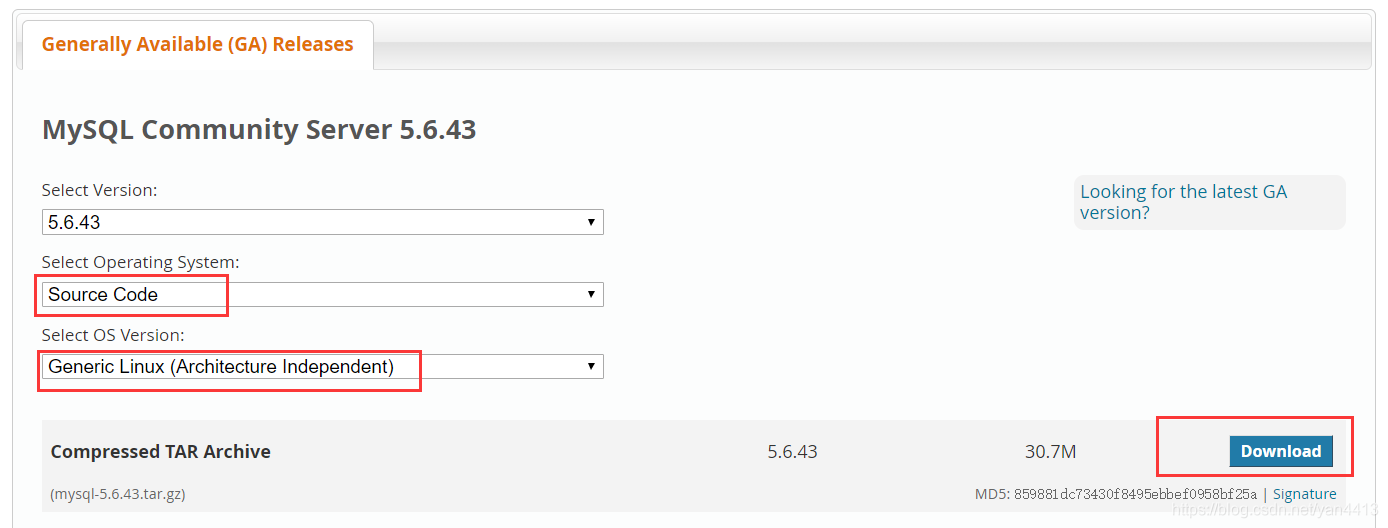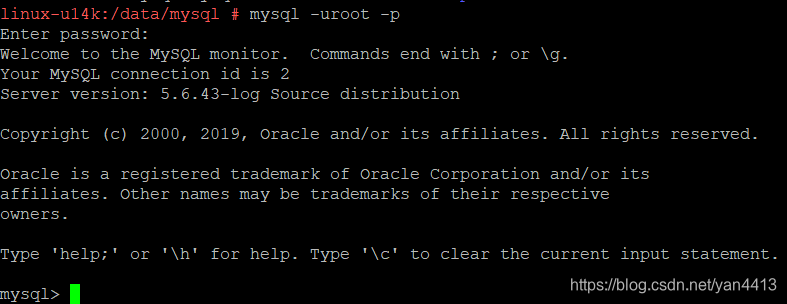参考博文:http://blog.51cto.com/10759919/2155412
一、依赖包有tack、ncurses-devel、bison
二、二进制安装cmake-3.13.3-Linux-x86_64
下载地址:https://cmake.org/download/

下载好了后上传至服务器,解压缩后,重命名为cmake

将cmake命令添加到环境变量
这里我只是临时添加环境变量
# export PATH=$PATH:/usr/local/cmake/bin三、MySQL服务器安装
1、创建群组及用户
groupadd mysql
useradd -g mysql mysql2、创建相关目录
mkdir -p /data/mysql/{data,tmp} #创建存放数据文件目录,data与tmp之间不能为空格
chown -R mysql.mysql /data/mysql3、上传mysql-5.6.43.tar.gz文件并解压(我上传至/usr/local目录下)
tar -zxvf mysql-5.6.43.tar.gzmysql-5.6.43.tar.gz下载地址:https://dev.mysql.com/downloads/mysql/5.6.html#downloads

4、编译安装
cd mysql-5.6.43
cmake . -DCMAKE_INSTALL_PREFIX=/root/mysql \
-DSYSCONFDIR=/data/mysql \
-DMYSQL_DATADIR=/data/mysql/data \
-DMYSQL_UNIX_ADDR=/data/mysql/mysql.sock \
-DMYSQL_TCP_PORT=3306 \
-DWITH_ARCHIVE_STORAGE_ENGINE=1 \
-DWITH_BLACKHOLE_STORAGE_ENGINE=1 \
-DWITH_PARTITION_STORAGE_ENGINE=1 \
-DENABLED_LOCAL_INFILE=1 \
-DDEFAULT_CHARSET=utf8 \
-DDEFAULT_COLLATION=utf8_general_ci \
-DEXTRA_CHARSETS=all
make && make install四、初始化数据库
/root/mysql/scripts/mysql_install_db --basedir=/root/mysql --datadir=/data/mysql/data --user=mysql五、创建配置文件/etc/my.cnf
参考内容:
# For advice on how to change settings please see
# http://dev.mysql.com/doc/refman/5.7/en/server-configuration-defaults.html
[client]
#password = your_password
port = 3306
socket = /data/mysql/mysql.sock
default-character-set=utf8
# Here follows entries for some specific programs
# The MySQL server
[mysqld]
port = 3306
basedir = /root/mysql
datadir = /data/mysql/data
tmpdir = /data/mysql/tmp
socket = /data/mysql/mysql.sock
character-set-server = utf8
collation-server = utf8_general_ci
pid-file = /data/mysql/mysql.pid
user = mysql
explicit_defaults_for_timestamp
lower_case_table_names = 1
max_connections = 1000
back_log = 1024
open_files_limit = 10240
table_open_cache = 5120
#bind-address = 127.0.0.1
#skip-name-resolve
skip-external-locking
local-infile = 1
key_buffer_size = 32M
max_allowed_packet = 1M
table_open_cache = 64
sort_buffer_size = 512K
net_buffer_length = 8K
read_buffer_size = 256K
read_rnd_buffer_size = 512K
myisam_sort_buffer_size = 8M
# Don't listen on a TCP/IP port at all. This can be a security enhancement,
# if all processes that need to connect to mysqld run on the same host.
# All interaction with mysqld must be made via Unix sockets or named pipes.
# Note that using this option without enabling named pipes on Windows
# (via the "enable-named-pipe" option) will render mysqld useless!
#
#skip-networking
# Replication Master Server (default)
# binary logging is required for replication
log-bin = /data/mysql/mysql-bin
# binary logging format - mixed recommended
binlog_format = mixed
# required unique id between 1 and 2^32 - 1
# defaults to 1 if master-host is not set
# but will not function as a master if omitted
server-id = 1
# Replication Slave (comment out master section to use this)
#
# To configure this host as a replication slave, you can choose between
# two methods :
#
# 1) Use the CHANGE MASTER TO command (fully described in our manual) -
# the syntax is:
#
# CHANGE MASTER TO MASTER_HOST=<host>, MASTER_PORT=<port>,
# MASTER_USER=<user>, MASTER_PASSWORD=<password> ;
#
# where you replace <host>, <user>, <password> by quoted strings and
# <port> by the master's port number (3306 by default).
#
# Example:
#
# CHANGE MASTER TO MASTER_HOST='125.564.12.1', MASTER_PORT=3306,
# MASTER_USER='joe', MASTER_PASSWORD='secret';
#
# OR
#
# 2) Set the variables below. However, in case you choose this method, then
# start replication for the first time (even unsuccessfully, for example
# if you mistyped the password in master-password and the slave fails to
# connect), the slave will create a master.info file, and any later
# change in this file to the variables' values below will be ignored and
# overridden by the content of the master.info file, unless you shutdown
# the slave server, delete master.info and restart the slaver server.
# For that reason, you may want to leave the lines below untouched
# (commented) and instead use CHANGE MASTER TO (see above)
#
# required unique id between 2 and 2^32 - 1
# (and different from the master)
# defaults to 2 if master-host is set
# but will not function as a slave if omitted
#server-id = 2
#
# The replication master for this slave - required
#master-host = <hostname>
#
# The username the slave will use for authentication when connecting
# to the master - required
#master-user = <username>
#
# The password the slave will authenticate with when connecting to
# the master - required
#master-password = <password>
#
# The port the master is listening on.
# optional - defaults to 3306
#master-port = <port>
#
# binary logging - not required for slaves, but recommended
#log-bin=mysql-bin
# Uncomment the following if you are using InnoDB tables
#innodb_data_home_dir = /var/lib/mysql
innodb_data_file_path = ibdata1:10M:autoextend
#innodb_log_group_home_dir = /var/lib/mysql
# You can set .._buffer_pool_size up to 50 - 80 %
# of RAM but beware of setting memory usage too high
innodb_buffer_pool_size = 256M
#innodb_additional_mem_pool_size = 2M
# Set .._log_file_size to 25 % of buffer pool size
#innodb_log_file_size = 5M
#innodb_log_buffer_size = 8M
#innodb_flush_log_at_trx_commit = 1
#innodb_lock_wait_timeout = 50
innodb_buffer_pool_instances = 2
innodb_read_io_threads = 8
innodb_write_io_threads = 8
innodb_purge_threads = 1
slow_query_log = 1
long_query_time = 10
log-queries-not-using-indexes
log-error = /data/mysql/mysql.err
expire-logs-days = 10
[mysqldump]
quick
max_allowed_packet = 512M
net_buffer_length = 16384
[mysql]
auto-rehash
# Remove the next comment character if you are not familiar with SQL
#safe-updates
[myisamchk]
key_buffer_size = 20M
sort_buffer_size = 20M
read_buffer = 2M
write_buffer = 2M
[mysqlhotcopy]
interactive-timeout六、环境变量配置
echo 'export PATH=/root/mysql/bin:$PATH' >> /etc/profile
source /etc/profile七、启动MySQL并添加到服务
touch /data/mysql/mysql.err #当前版本该文件不会自动创建,需要手工创建
chown mysql.mysql /data/mysql/mysql.err
cp /root/mysql/support-files/mysql.server /etc/init.d/mysql
chkconfig --add mysql # 添加开机启动
service mysql start查看mysql
![]()
八、root登录密码配置
mysqladmin -u root password 'root'九、客户端连接mysql (密码为上步所设置的)

十、开放3306端口
vi /etc/sysconfig/SuSEfirewall2
rcSuSEfirewall2 restart#关闭mysql
service mysql stop
#启动mysql
service mysql start
#重启mysql
service mysql restart







 本文详细介绍了在Linux环境下MySQL服务器的安装与配置步骤,包括依赖包安装、二进制安装CMake、MySQL编译安装、数据库初始化、配置文件设置、环境变量配置、服务启动与管理,以及端口开放等关键操作。
本文详细介绍了在Linux环境下MySQL服务器的安装与配置步骤,包括依赖包安装、二进制安装CMake、MySQL编译安装、数据库初始化、配置文件设置、环境变量配置、服务启动与管理,以及端口开放等关键操作。
















 238
238










